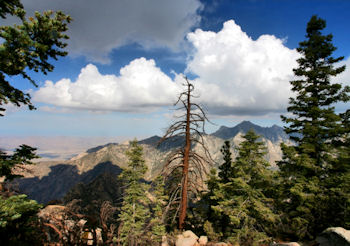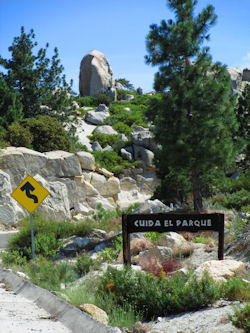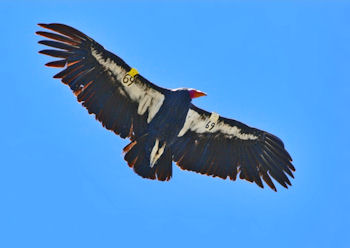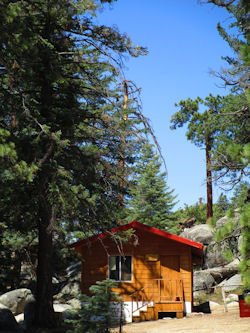 |  |
By Martina

"May your trails be crooked, winding, lonesome, dangerous, leading to the most amazing view. May your mountains rise into and above the clouds." Edward Abbey
Making a trip into the high country of Baja California is just that and more. It rewards the traveler with breathtaking views of the folding foothills all the way out to the Pacific Ocean, while making a journey through five different ecoregions. The paved road to Sierra San Pedro Mártir National Park is narrow hairpin turns, straight up. It takes about 45 minutes to drive the 21 miles from Rancho Meling to reach the 10,000-foot summit where the second largest observatory in the world sits like a cap on the granite peak. Here the air is rarified and you see why the observatory was built for star gazing.

Starting in rolling foothills you drive through dry sandy arroyos. The road is lined with aqua-green Basin Sage standing nearly 3-feet tall, its distinctive fragrance is carried on the breeze. The climb is rapid. You drop through a series of higher and higher valleys. Plunging down into the last valley before making the final ascent, you see a stunning wall of mountain. You might wonder how a road could ever be built there. Soon you find out the truth as the road continues through white granite passes, sliced from the solid rock. A slender king snake crosses in front of the car, a bevy of baby quail scatter in all directions, and tiny lizards do pushups in the pools of sunlight. It is a driving gauntlet and a must to miss them all as they are protected creatures. Scarlet and blue flowers cling to the crevices, sunlight catches the graceful grasses in ethereal light. A master gardener’s handy work. The first Ponderosa pine and fir are seen gaining a foothold in the steep rocky terrain. Nearing the park entrance the trees command attention from the Lodgepole pine to the majestic Sugar Pine with cones 18” or more, hanging from the tips of its branches. The air is filled with the scent of warm pine needles.
Pulling into to the Ranger Station there is one small building and a single Ranger on duty who had me sign in and pay the 54 pesos entrance fee, approximately $5. All information was printed in Spanish, however a clever map of the area was very helpful. I was surprised to find cute little cabins for rent. I wondered why I had not discovered this before or had never taken advantage of this wonderful opportunity. A few miles down the road is a modern museum, but it was closed with no hours posted. From here it is only 8 miles to the observatory.

A few helpful signs were in English on a topic of which I have great interest. The reestablishment of the California Condor is making significant progress with the support of the Mexican government and other agencies on both sides of the border. Horacio Gonzalez, Sustainable Development Coordinator for Terra Peninsular in Ensenada is working along with Serge Dedina, Director of WildCoast in the U.S. and others. The Park sign told the story:
"More than 50 thousand years ago, the California condor inhabited the west coast of North America from Canada to Baja California. By the 1930s, the condor was on the brink of extinction. There were only 22 individuals left in the world. The causes of their drastic reduction were hunting, lead and pesticide poisoning, collisions with power-lines and swallowing pieces of garbage."

"Gone from Baja California since the fifties, condors now fly freely again in this region. Condors are not hunters but scavengers (they eat only carcasses), so they are considered “cleaners of the environment.” They feed and fly in groups, rarely alone. Searching for food they can fly 160 miles in a day. They have a 9-foot wingspan and a bald head; black in youngsters and red in adults. Condors mate for life and lay one egg every two years. The California condor is a case of successful reintroduction of a species that had already disappeared from our territory."
It was lunch time and I pulled into Campo Condor hoping it would give me some luck in actually seeing them in flight. I had not seen another visitor in all this time. I was alone. I once lived and worked in Yosemite National Park where four million people visit each year. Camping was at a premium and elbow to elbow. Like Edward Abbey I enjoy the lonesomeness of having the living forest to myself and was not at all worried about any danger, save for a tiny Nut Hatch that swooped in for a few crumbs. The campsites are so far apart I couldn’t have seen my neighbor even if there had been one. Picnic tables, fire rings and barbeques are furnished. Even the port-a-potties were modern. I remember reading something that Abbey said years ago. He was a fire lookout and he was sitting on a rock looking up into the sky. A visitor walked by and asked him what he was doing. "Looking at clouds" was his reply. The visitor asked confused, "Why?"

Abbey answered, "Well, someone has to." If it is good enough for Edward Abbey it is good enough for me. And I spent the rest of the afternoon gazing at clouds, listening to the wind and receiving the gift of peace the forest offered.
San Pedro Mártir cabin rentals – 646-172-3000, Ext 3229
Wildcoast – 619-423-8488
Terra Peninsular – 646-177-6800
Flying condor photo courtesy of Doug Gould and the Baja Sun
Martina's email: mteomaya(at)gmail.com

Easy buying website understands all I need

Great company and they use CHUBB which is a top notch insurance company.We got our policy online...